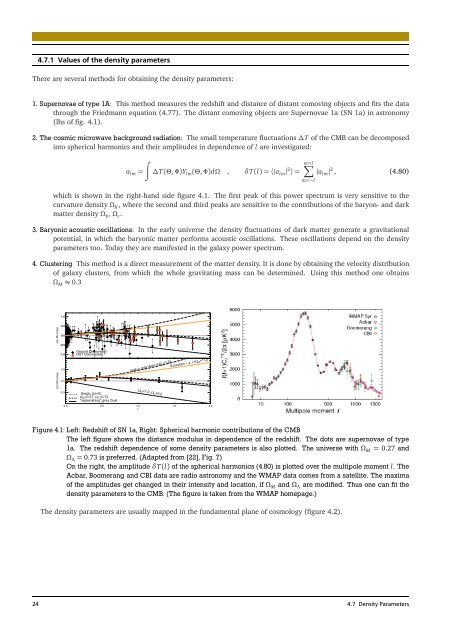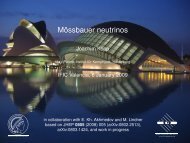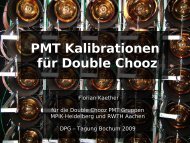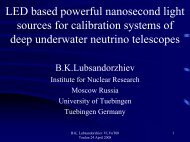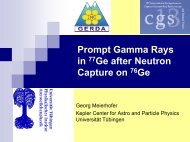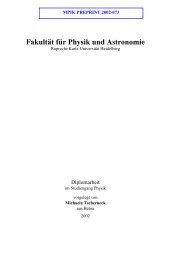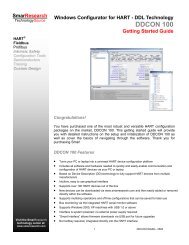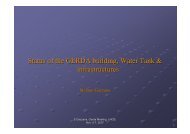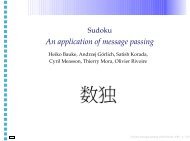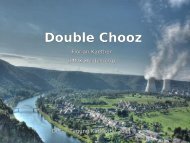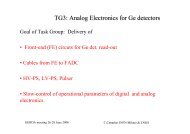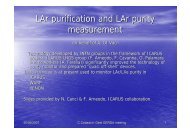Master Thesis
Master Thesis
Master Thesis
You also want an ePaper? Increase the reach of your titles
YUMPU automatically turns print PDFs into web optimized ePapers that Google loves.
4.7.1 Values ofthedensityparameters<br />
There are several methods for obtaining the density parameters:<br />
1. Supernovaeoftype 1A: This method measures the redshift and distance of distant comoving objects and fits the data<br />
through the Friedmann equation (4.77). The distant comoving objects are Supernovae 1a (SN 1a) in astronomy<br />
(lhs of fig. 4.1).<br />
2. The cosmicmicrowavebackgroundradiation: The small temperature fluctuations∆T of the CMB can be decomposed<br />
into spherical harmonics and their amplitudes in dependence of l are investigated:<br />
a lm=<br />
�<br />
∆T(Θ,Φ)Y lm(Θ,Φ)dΩ , δT(l)=〈|a lm| 2 〉=<br />
�m=l<br />
m=−l<br />
|a lm| 2 , (4.80)<br />
which is shown in the right-hand side figure 4.1. The first peak of this power spectrum is very sensitive to the<br />
curvature densityΩ K, where the second and third peaks are sensitive to the contributions of the baryon- and dark<br />
matter densityΩ b,Ω c.<br />
3. Baryonicacoustic oscillations: In the early universe the density fluctuations of dark matter generate a gravitational<br />
potential, in which the baryonic matter performs acoustic oscillations. These oscillations depend on the density<br />
parameters too. Today they are manifested in the galaxy power spectrum.<br />
4. Clustering This method is a direct measurement of the matter density. It is done by obtaining the velocity distribution<br />
of galaxy clusters, from which the whole gravitating mass can be determined. Using this method one obtains<br />
Ω M≈ 0.3<br />
∆(m-M) (mag)<br />
∆(m-M) (mag)<br />
1.0<br />
0.5<br />
0.0<br />
-0.5<br />
-1.0<br />
0.5<br />
0.0<br />
-0.5<br />
Ground Discovered<br />
HST Discovered<br />
Empty (Ω=0)<br />
Ω M=0.27, Ω Λ=0.73<br />
"replenishing" gray Dust<br />
high-z gray dust (+Ω M=1.0)<br />
Ω M=1.0, Ω Λ=0.0<br />
Evolution ~ z, (+Ω M=1.0)<br />
0.0 0.5 1.0 1.5 2.0<br />
z<br />
Figure4.1: Left: Redshift of SN1a,Right: Sphericalharmoniccontributionsof the CMB<br />
The left figure shows the distance modulus in dependence of the redshift. The dots are supernovae of type<br />
1a. The redshift dependence of some density parameters is also plotted. The universe withΩ M = 0.27 and<br />
Ω Λ= 0.73 ispreferred. (Adaptedfrom [22], Fig. 7)<br />
On the right, the amplitudeδT(l) of the sphericalharmonics (4.80) is plotted over the multipole moment l. The<br />
Acbar, Boomerang and CBI data are radioastronomy and the WMAP data comes from a satellite. The maxima<br />
of the amplitudes get changed in their intensity and location, ifΩ M andΩ Λ are modified. Thus one can fit the<br />
density parameterstothe CMB. (The figureistaken fromthe WMAP homepage.)<br />
The density parameters are usually mapped in the fundamental plane of cosmology (figure 4.2).<br />
24 4.7 Density Parameters


